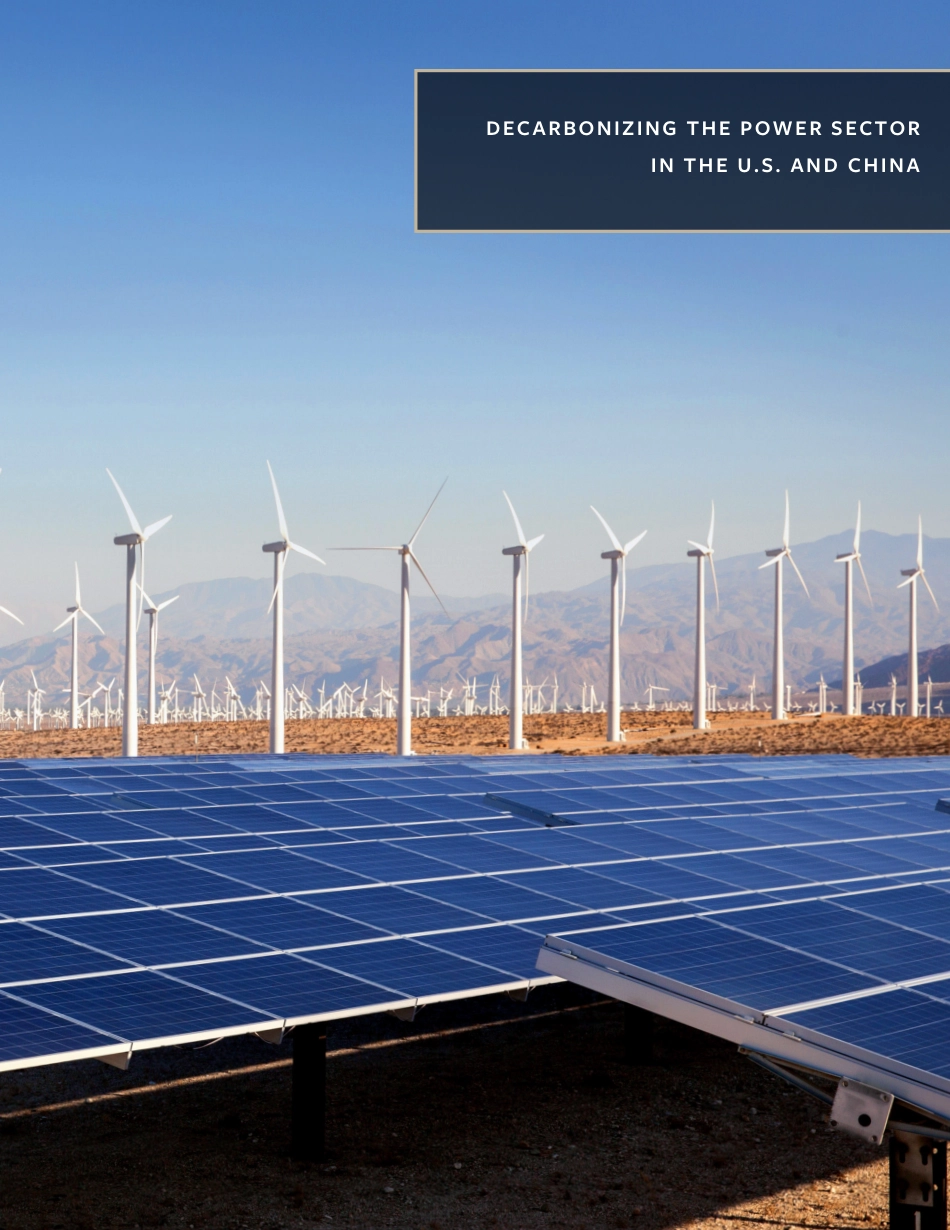THEU.S.ANDCHINANEEDTOREDUCEMETHANEEMISSIONS,SUBSTANTIALLYANDCOLLABORATIVELYDECARBONIZINGTHEPOWERSECTORINTHEU.S.ANDCHINA1DECARBONIZINGTHEPOWERSECTORINTHEU.S.ANDCHINAMikeO’Boyle,EnergyInnovation*MaxDupuy,RegulatoryAssistanceProject**Organizationsarenotedforaffiliationpurposesonly.Thispaperrepresentsauthors’views,andnotnecessarilythoseoftheirinstitutions.KEYISSUESANDTRENDSTogether,theUnitedStates’andChinesepowersystemsemitted5,780millionmetrictonsofcarbondioxideequivalent(CO₂e)in2020,about36%ofthetwocountries’and17%oftheworld’sannualcarbonemissions(InternationalEnergyAgency2022).Consensusisgrowingamongthescientificcommunitythatmajorityrenewables-basedelectricitysystemsexceeding80%carbon-freecanbeoperatedreliablyandatlowcost,withoutdevelopingnewtechnologies(Abhyankaretal.2022;MacDonaldetal.2016;Novacheck,Brinkman,andPorro2018;NREL2012;Phadkeetal.2020).TheU.S.andChinafacesimilarphysicalandpolicychallengestotransformtheirpowersectors,despitedifferenteconomicandinstitutionalconditions.Thetransitiontoarenewables-basedelectricitysystemisalsoessentialfordecarbonizingend-uses–suchastransportationandheatingofbuildings–throughelectrification.TheNationallyDeterminedContributions(NDC)ofbothcountriesundertheUnitedNationsFrameworkConventiononClimateChangeincludesignificantpowersectorcommitments.Figure1|U.S.andChinaElectricitySectorGreenhouseGasEmissions,2000-2019.Datasource:ClimateWatch(https://www.climatewatchdata.org/ghg-emissions?end_year=2019®ions=CHN%2CUSA§ors=electricity-heat&start_year=1990)2However,giventhatneithercountry’sNDCpledgesfor2030aresufficienttosupporta1.5degreesCpathway,andgiventhecentralityofthepowersectortodecarbonizationefforts,bothmustconsiderredoublingeffortstoreducepowersectoremissions.Thegoodnewsisthatwell-understoodandfeasiblepolicypathways,applicabletobothcountries,canimprovereliabilityandhelpreducecostswhileacceleratingthepowersectortransformation.TheU.S.recentlycommittedtoreducingeconomy-widenetgreenhousegasemissionsby50%below2005levelsby2030,azero-carbonpowersectorby2035andanet-zeroemissionseconomybynolaterthan2050.TheU.S.electricitysectormustreduceemissionsapproximately80%below2005levelsby2030inordertomeetthe2030nationaltarget(Abhyankaretal.2021;Larsenetal.2021;Larsonetal.2021).WhiletheU.S.electricitysectorhassubstantiallyreducedemissionsfromitspeakin2005,andiscurrently40%carbon-free,reaching80%carbon-freein2030and100%in2035wouldrepresentadramaticaccelerationofcleanenergydeploymentandfossilretirement.Sectorexpertswidelyagreethatmeetingthesetargetsispossible,wouldmarkedlyimprovepublichealth,createnewjobs,andevenpotentiallyreduceconsumerelectricitycosts(Abhyankaretal.2022).However,doingsowillrequireadditionalpolicy,includingnewfederalregulationandsub-nationalaction.U.S.effortsatthefederalandsub-nationallevelsareevolving.Twenty-onestatesplustheDistrictofColumbiaandPuertoRico,representingone-thirdofelectricgeneration,havesetgoalsfor100%cleanelectricity,althoughmanyoftheseare2050goals,not2035asintheU.S.nationalcommitment.139ofthe41largestutilitiesintheU.S.havemadepubliccommitmentstohitnetzeroemissionsbymidcentury(EspositoandJeffrey2022).TheU.S.passedamajorinfrastructurebillin2021whichincludesfundingforend-useenergyefficiencyandtransmissionprojects(alongwithprovisionstosupporttransmissionsitingauthorization)thatwillsupportrenewableprojectdevelop...



 VIP
VIP VIP
VIP VIP
VIP VIP
VIP VIP
VIP VIP
VIP VIP
VIP VIP
VIP VIP
VIP VIP
VIP